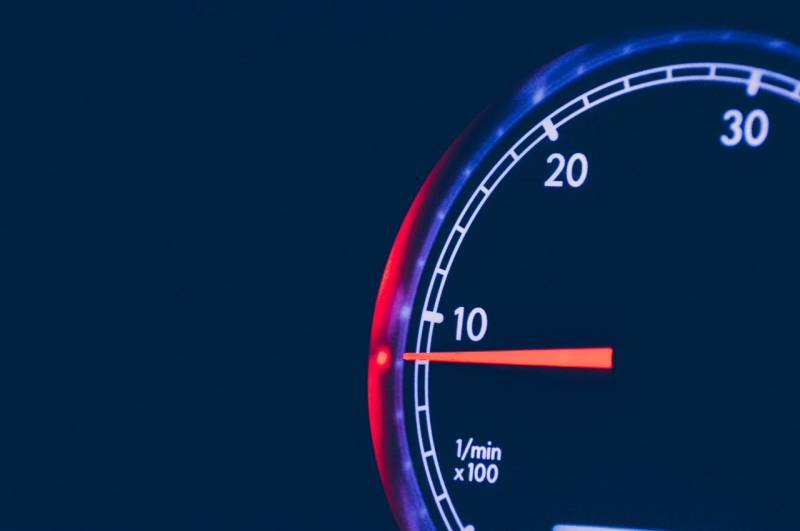Quick Navigation

There is a chance that you’ve experienced a fluctuating RPM while driving. RPM is critical as it indicates the best time to shift into a higher or lower gear.
So, if it’s not working correctly, you will have to address the problem as soon as possible.
In this post, we’re going to highlight some of the factors that make the RPM fluctuate and how to fix them. These are as follows:
1. A Bad Crankshaft Position Sensor
The first part to check out when your vehicle’s RPM is fluctuating is the crankshaft position sensor. The crankshaft sensor is connected to the engine block facing the timing rotor on the engine crankshaft. It detects signals utilized by the engine ECU to calculate the crankshaft position and the engine rotational speed.
In short, it measures the rotation speed or RPM and the exact position of the engine crankshaft.
So, if the crankshaft position sensor is damaged, it can cause the RPM to fluctuate. Additionally, it may lead to the car stalling, long crank time before the engine starts, vibrations in the engine, or the engine might have trouble starting. Regardless, a bad crankshaft sensor can be fixed easily.
But first, you need to test it and find out if it has cracks, corroded connector pins, or any other damage.
How To Fix It
Fixing your car’s damaged crankshaft position sensor is essential as it will send the right signals to the engine control unit (ECU). If you’ve never diagnosed a car before, you should take it to a mechanic. But if you’re a DIY enthusiast, follow the procedure:
Step 1: Before attempting any repair work on the crankshaft position sensor, you should disconnect your car battery. This helps to prevent damage to your car’s electronic panel.
Step 2: Go through your car’s owner’s manual to detect the crankshaft position. This varies from one car to another. In some vehicles, the crankshaft position sensor may be located close to the main pulley, and in others, it could be at the transmission bell housing or in the engine cylinder block.
Step 3: After detecting the crankshaft position sensor, disconnect the wire harness. This will allow you to remove the crankshaft position sensor and inspect it. Take a picture before removing the sensor so that you can have a simple time returning it.
Step 4: Disconnect the sensor and replace it with a new one. Then, reconnect the wiring harness in the same position it was before.
Step 5: If you’re confident that it is firm and in position, you can reconnect the battery and test your crankshaft position sensor. If the sensor was the problem, then your RPM won’t move back and forth as before during driving.
2. Worn Out Spark Plugs
Worn out spark plugs can cause your car’s RPM to fluctuate. This is very common in older cars. If the spark plug is dirty or worn out, the RPM will drop or surge.
Other signs of a bad spark plug include excess vibration, poor acceleration, bad fuel economy, hard to start, engine misfiring, and strong fuel smell from the car’s exhaust.
If you notice one of these signs apart from fluctuating RPM, you should change the spark plugs as soon as possible. Car spark plugs are crucial as they produce electric sparks that ignite the fuel-air mixture in the engine cylinder to create energy. Most spark plugs have a lifespan of 100 000 miles.
How To Fix It
To prevent your vehicle from fluctuating RPM, you will have to replace the worn-out spark plugs. Here is the procedure of removing and replacing the bad spark plug from your ar.
Step 1: Locate the spark plug. Spark plugs can be found in the cylinder head, which is directly above the cylinder combustion chamber. Nevertheless, you should note that different engines have their cylinder heads in different positions.
Step 2: After locating the cylinder head, you will start by removing the ignition coils or cables covering the engine.
Step 3: The spark plugs will be on top of the cylinder. Take a picture and remove them so that you can return the new ones correctly.
Step 4: Get the new spark plugs and install them. Make sure the new spark plugs are of the same length as the old ones.
Step 5: Finally, spray some lube on the spark plugs and at the threads and fasten them. You can now return the ignition coils and cables that you removed earlier.
3. Defective Idle Air Control Valve
Another common reason why your car’s RPM may be fluctuating is a bad idle air control valve. The control valve is needed to manage the engine idle speed so that it remains at a normal rate. If the control valve is bad, it will not execute its task well.
As a result, the RPM may fluctuate. Other signs of a defective idle air control valve include rough idling, engine stalling, check engine light coming on, and load causes stalling.

How To Fix It
Here is the procedure of how you can replace a bad control valve. But if you don’t have the skills or the confidence to diagnose the car, you can hire a professional mechanic.
Step 1: Start by parking your car and turning off the engine. Additionally, the area should have adequate space and lighting. The best place to make car repairs and replacements is the garage. Disconnect the battery and allow the car to cool down.
Step 2: Examine the idle air control valve and find out the problem. You can review the IAC valve using an OBDII scanner or inspecting the RPM. The best method is to check the RPM, which will allow you to find out if the control valve is bad and the issue it may be facing.
Step 3: After finding out the issue, the next step is to locate the control valve and fix it. Most vehicles have the control valve located next to the throttle body and in the manifold intake. If you’re not sure, you can check the owner’s manual. If you find the valve, disconnect the wiring harness.
Step 4: Remove the control valve and clean it thoroughly. In some situations, debris and carbon may build up; thus, preventing the valve from working efficiently.
Use a spray, cleaner, and clean cloth to ensure all the debris and carbon are removed. The cloth is for drying any liquid that remains behind.
Step 5: If the idle air control valve doesn’t function after cleaning, remove it, and replace it with a brand new one. This means that the IAC valve is defective and has to be replaced with a new one. After installing the new control valve, reconnect the wiring harness and the battery. You can now test the RPM and see if it’s back to normal.
4. Vacuum Leak
An engine vacuum leak can also make your car’s RPM fluctuate. This leak usually occurs in the engine bay. Apart from your RPM fluctuating rapidly, other signs of a vacuum leak are a hissing sound, loss of power, low fuel efficiency, check engine light comes on, car stalling, and rough idle.
How To Fix It
Unlike the other cases that we’ve looked at, a vacuum leak cannot be diagnosed by yourself. Take the car to a professional mechanic for the repair of a vacuum leak.
If a vacuum leak is not repaired quickly, it may lead to some serious car problems. Also, it may be unsafe for driving and may result in an accident.
Conclusion
If you notice that your car’s RPM is fluctuating, you don’t have to panic as the issue can often be fixed easily. However, the first thing to do is to detect the problem your vehicle is facing. It may be a bad spark plug, bad crankshaft, damaged idle air control valve, uncalibrated throttle position sensor, or a vacuum leak.
Whatever the problem, our guide above should help you fix your car’s RPM and shift gears when the time is right.
Some of the problems that cause the car’s RPM to fluctuate can be fixed by a DIYer, but most of them should be left for a professional mechanic.
Get your car fixed as soon as possible to avoid any danger that a fluctuating RPM might cause. We hope that you’ve found the answers that you’ve been looking for!

Kevin has been hanging around cars and automobile magazines since he knew what a car is. He grew up in his father’s 1995 Mercedes E320 Wagon and Volkwagon Phaeton W12 2004. He rides his first car, a manual 1979 Porche 911SC.
Currently, he owns an Acura Integra GS-R. During his childhood, he showed a keen interest in how things actually work and fix them. This passion transforms into his eternal love for cars and bestows him an ideal position in one of the leading automobile companies; whenever he finds time, he takes out his Acura and opts for the longest possible route to find hidden wholesome pleasure in a road trip.
Want to read some of the articles written by Kevin? Head to our blog section to find out all the articles written by Kevin.






